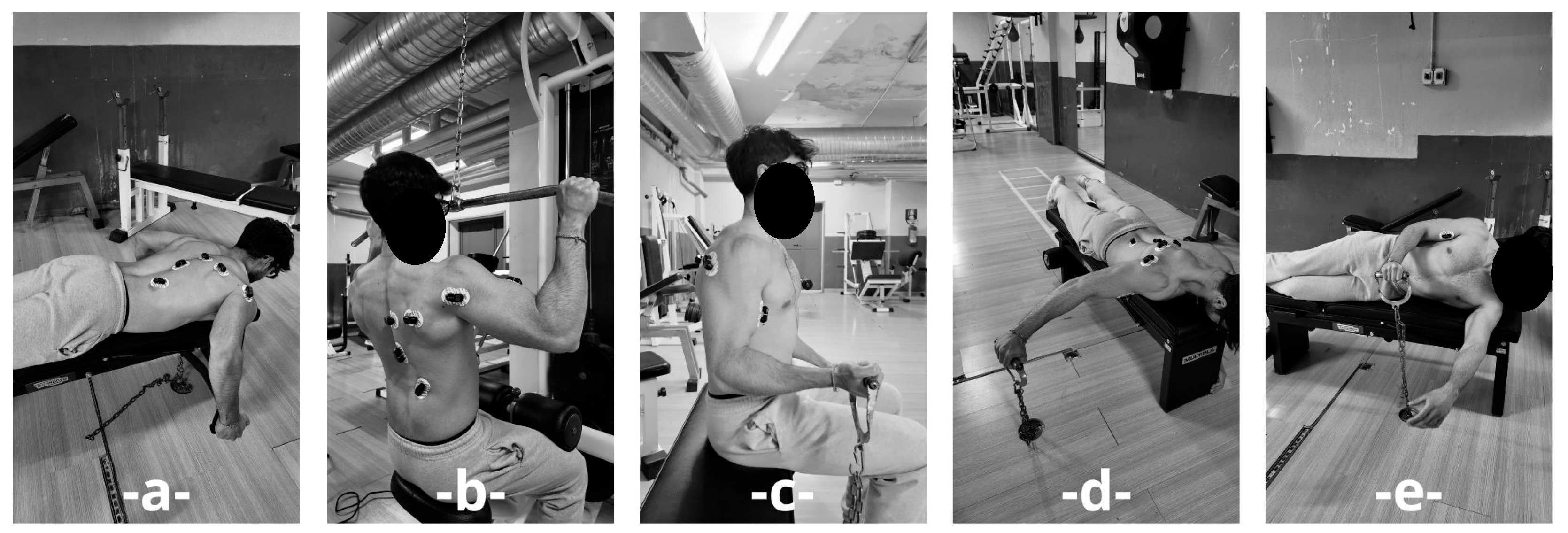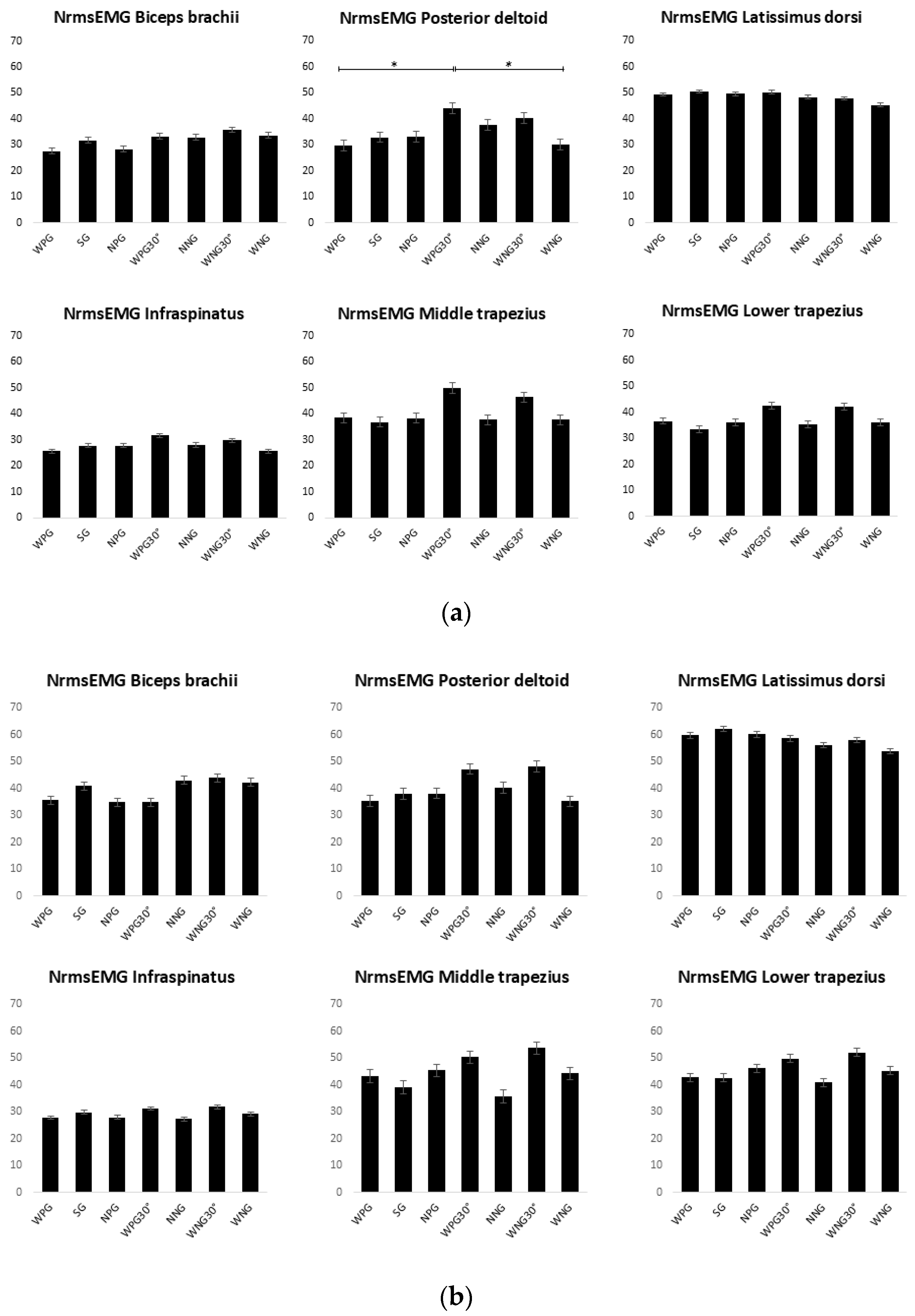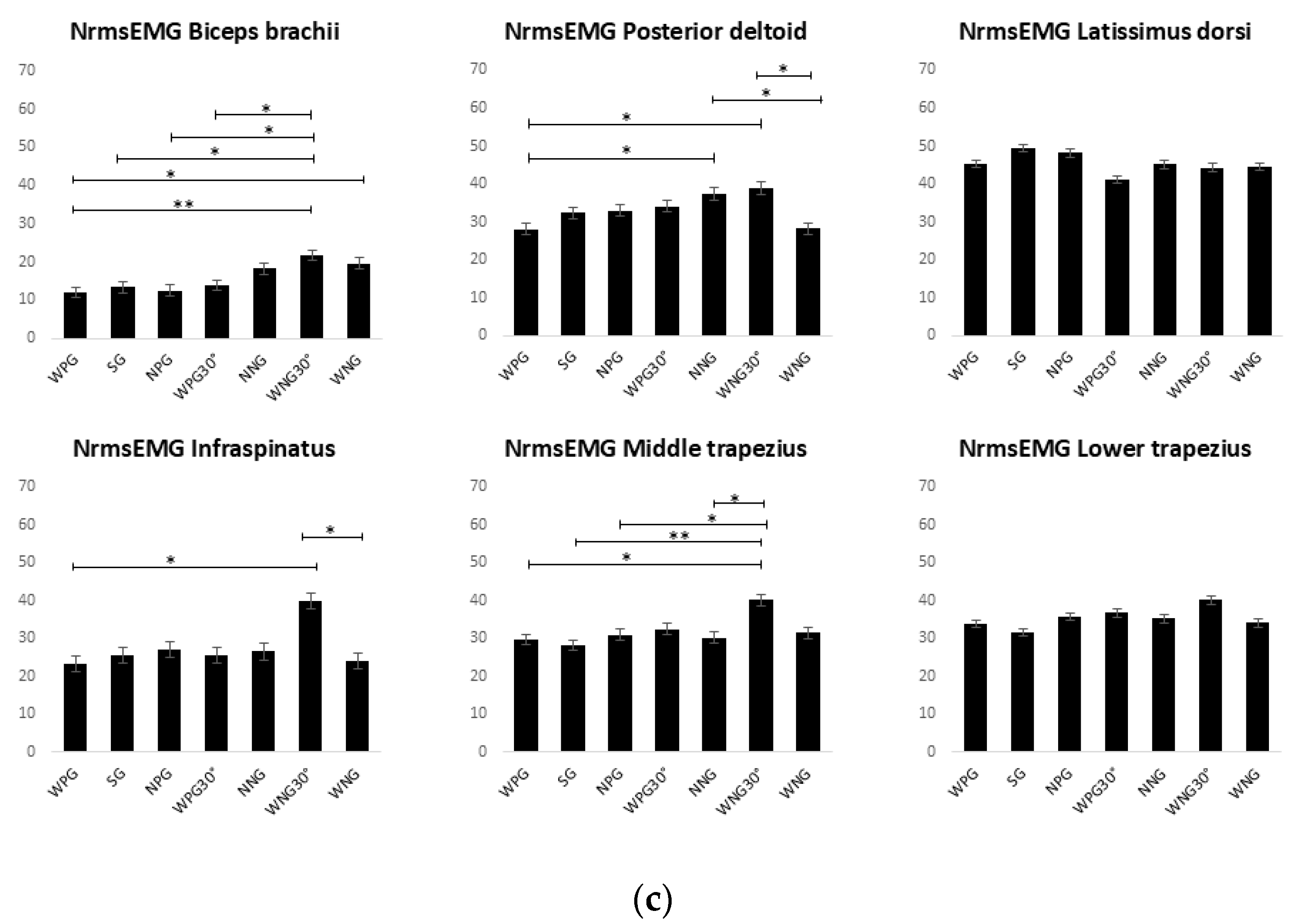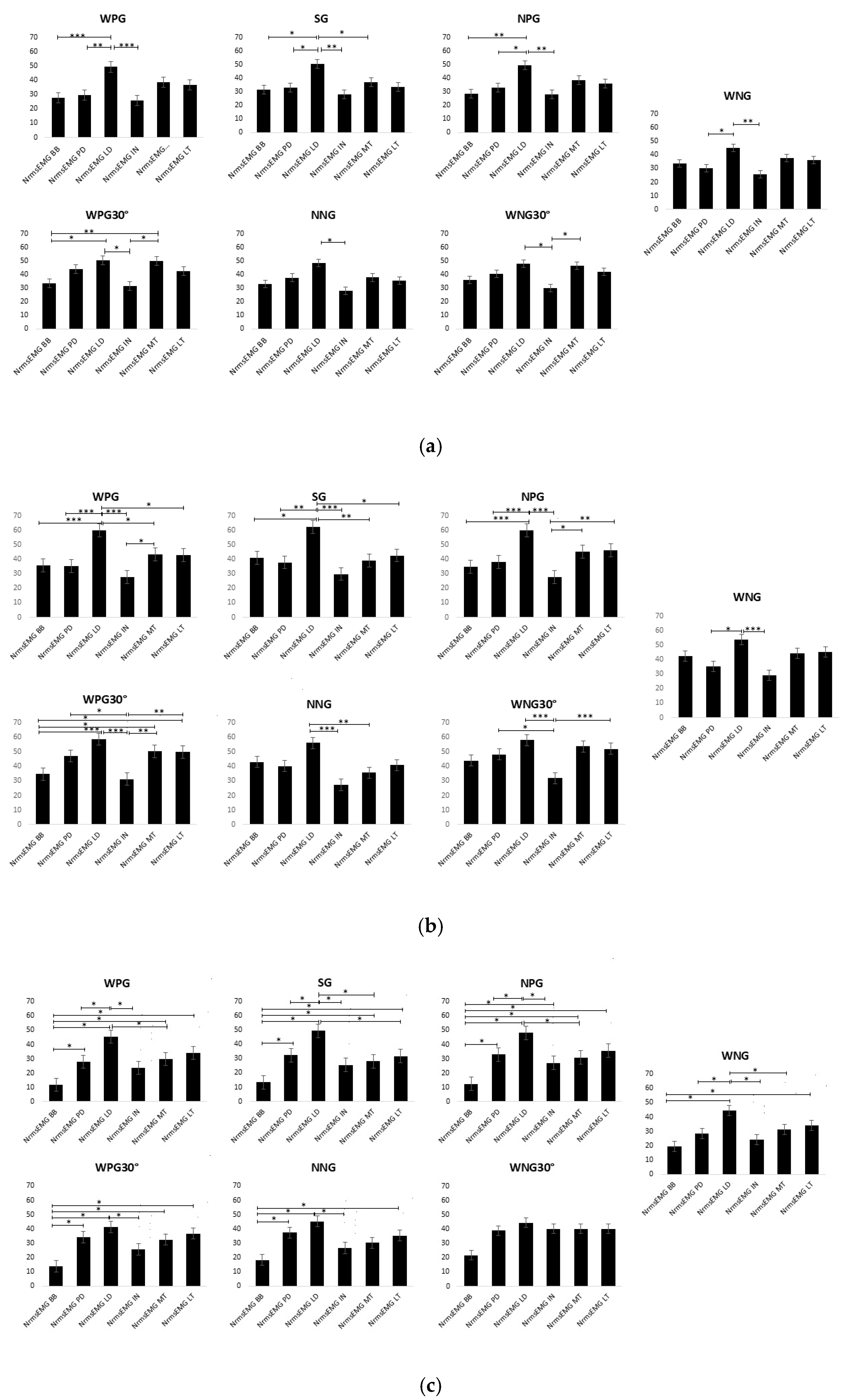Electromyographic Analysis of Back Muscle Activation During Lat Pulldown Exercise: Effects of Grip Variations and Forearm Orientation
Abstract
1. Introduction
2. Materials and Methods
2.1. Study Design
2.1.1. Participants
2.1.2. Experimental Procedure
2.2. EMG Measurement and Analysis
2.3. Statistical Analysis
3. Results
4. Discussion
5. Conclusions
Author Contributions
Funding
Institutional Review Board Statement
Informed Consent Statement
Data Availability Statement
Conflicts of Interest
Abbreviations
| MVC | Maximal Voluntary Contraction |
| sEMG | Surface Electomyography |
| rmsEMG | Root Mean Square Electromyography |
| NrmsEMG | Normalised Root Mean Square of the electromyography |
| WPG | Wide Pronated Grip |
| NPG | Narrow Prone Grip |
| SG | Supinated Grip |
| WPG30° | Wide Pronated Grip with 30° trunk inclination |
| NNG | Narrow Neutral Grip |
| WNG30° | Wide Neutral Grip with 30° trunk inclination |
| WNG | Wide Neutral Grip |
| LD | Latissimus Dorsi |
| MT | Middle Trapezius |
| LT | Lower Trapezius |
| PD | Posterior Deltoid |
| BB | Biceps Brachii |
| IN | Infraspinatus |
References
- Hatfield, F.C.; Krotee, M. Personalized Weight Training for Fitness and Athletics: From Theory to Practice; Kendall/Hunt Publishers: Dubuque, IA, USA, 1984. [Google Scholar]
- Wills, R.; Signorile, J.F.; Perry, A.; Tremblay, L.; Kwiatkowski, K. Differences in EMG activity due to handgrip position during the lat pulldown. Med. Sci. Sports Exerc. 1994, 26, S20. [Google Scholar] [CrossRef]
- Berger, R.A. Introduction to Weight Training; Prentice Hall: Englewood Cliffs, NJ, USA, 1984. [Google Scholar]
- Kinzey, S. The lat pulldown. Strength Cond. 1998, 20, 76. [Google Scholar]
- Weineck, J. Functional Anatomy in Sport; Mosby Yearbook: St. Louis, MO, USA, 1990. [Google Scholar]
- Baechle, T.R.; Earle, R.W.; Allerheiligen, W.B. Strength training and spotting techniques. In Essentials of Strength Training and Conditioning; Baechle, T.R., Ed.; Human Kinetics: Champaign, IL, USA, 1994; pp. 345–400. [Google Scholar]
- Crate, T. Analysis of the lat pulldown. Strength Cond. 1997, 19, 26–29. [Google Scholar] [CrossRef]
- Sperandei, S.; Barros, M.A.; Silveira-Júnior, P.C.; Oliveira, C.G. Electromyographic analysis of three different types of lat pull-down. J. Strength Cond. Res. 2009, 23, 2033–2038. [Google Scholar] [CrossRef]
- Lusk, S.J.; Hale, B.D.; Russell, D.M. Grip width and forearm orientation effects on muscle activity during the lat pull-down. J. Strength Cond. Res. 2010, 24, 1895–1900. [Google Scholar] [CrossRef]
- Signorile, J.F.; Szwed, S.P.; Zink, A.J. A Comparative Electromyographical Investigation of Muscle Utilization Patterns Using Various Hand Positions During the Lat Pull-down. J. Strength Cond. Res. 2002, 16, 539. [Google Scholar] [PubMed]
- Lehman, G.J.; Buchan, D.D.; Lundy, A.; Myers, N.; Nalborczyk, A. Variations in muscle activation levels during traditional latissimus dorsi weight training exercises: An experimental study. Dyn. Med. 2004, 3, 4. [Google Scholar] [CrossRef]
- Marshall, P.W.; McEwen, M.; Robbins, D.W. Strength and neuromuscular adaptation following one, four, and eight sets of high intensity resistance exercise in trained males. Eur. J. Appl. Physiol. 2011, 111, 3007–3016. [Google Scholar] [CrossRef]
- Stegeman, D.; Hermens, H. Standards for surface electromyography: The European project Surface EMG for non-invasive assessment of muscles (SENIAM). Enschede Roessingh Res. Dev. 2007, 10, 8–12. [Google Scholar]
- Snyder, B.J.; Leech, J.R. Voluntary increase in latissimus dorsi muscle activity during the lat pull-down following expert instruction. J. Strength Cond. Res. 2009, 23, 2204–2209. [Google Scholar] [CrossRef] [PubMed]
- Andersen, V.; Fimland, M.S.; Wiik, E.; Skoglund, A.; Saeterbakken, A.H. Effects of grip width on muscle strength and activation in the lat pull-down. J. Strength Cond. Res. 2014, 28, 1135–1142. [Google Scholar] [CrossRef] [PubMed]
- Snarr, R.; Eckert, R.M.; Abbott, P. A comparative analysis and technique of the Lat Pull-down. J. Strength Cond. Res. 2015, 37, 21–25. [Google Scholar] [CrossRef]
- Saeterbakken, A.H.; Andersen, V.; van den Tillaar, R. Comparison of muscle activation and kinematics in the lat-pulldown with different hand positions. J. Strength Cond. Res. 2017, 31, 3021–3029. [Google Scholar]
- Iglesias, Y.T.; Romero, R.B.; Fernández, D.A.; Sánchez, A.G. Comparison of the electromyographic ac-tivity of the muscles involved in low pulley horizontal rowing with different grips and bilateral widths. Retos Nuevas Tend. En Educ. Física Deporte Y Recreación 2024, 61, 302–309. [Google Scholar]
- Hess, S.A. Functional stability of the glenohumeral joint. Man. Ther. 2000, 5, 63–71. [Google Scholar] [CrossRef]





| Variable | Mean ± SD |
| Number of Participants | 40 |
| Age | 23.88 ± 3.56 |
| Body Mass (kg) | 77.49 ± 7.17 |
| Height (cm) | 176.27 ± 5.36 |
| BMI | 23.70 ± 1.85 |
Disclaimer/Publisher’s Note: The statements, opinions and data contained in all publications are solely those of the individual author(s) and contributor(s) and not of MDPI and/or the editor(s). MDPI and/or the editor(s) disclaim responsibility for any injury to people or property resulting from any ideas, methods, instructions or products referred to in the content. |
© 2025 by the authors. Licensee MDPI, Basel, Switzerland. This article is an open access article distributed under the terms and conditions of the Creative Commons Attribution (CC BY) license (https://creativecommons.org/licenses/by/4.0/).
Share and Cite
Buonsenso, A.; Di Fonza, D.; Di Claudio, G.; Carangelo, M.; Centorbi, M.; di Cagno, A.; Calcagno, G.; Fiorilli, G. Electromyographic Analysis of Back Muscle Activation During Lat Pulldown Exercise: Effects of Grip Variations and Forearm Orientation. J. Funct. Morphol. Kinesiol. 2025, 10, 345. https://doi.org/10.3390/jfmk10030345
Buonsenso A, Di Fonza D, Di Claudio G, Carangelo M, Centorbi M, di Cagno A, Calcagno G, Fiorilli G. Electromyographic Analysis of Back Muscle Activation During Lat Pulldown Exercise: Effects of Grip Variations and Forearm Orientation. Journal of Functional Morphology and Kinesiology. 2025; 10(3):345. https://doi.org/10.3390/jfmk10030345
Chicago/Turabian StyleBuonsenso, Andrea, Domenico Di Fonza, Gloria Di Claudio, Massimiliano Carangelo, Marco Centorbi, Alessandra di Cagno, Giuseppe Calcagno, and Giovanni Fiorilli. 2025. "Electromyographic Analysis of Back Muscle Activation During Lat Pulldown Exercise: Effects of Grip Variations and Forearm Orientation" Journal of Functional Morphology and Kinesiology 10, no. 3: 345. https://doi.org/10.3390/jfmk10030345
APA StyleBuonsenso, A., Di Fonza, D., Di Claudio, G., Carangelo, M., Centorbi, M., di Cagno, A., Calcagno, G., & Fiorilli, G. (2025). Electromyographic Analysis of Back Muscle Activation During Lat Pulldown Exercise: Effects of Grip Variations and Forearm Orientation. Journal of Functional Morphology and Kinesiology, 10(3), 345. https://doi.org/10.3390/jfmk10030345











